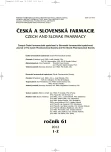Analytical profile of mono[{3-[4-(2-ethoxyethoxy)-benzoyloxy]-2-hydroxypropyl}-tert-butylammonium] fumarate
Authors:
Ivan Malík; Lenka Mitterová; Fils Andriamainty; Petr Mokrý 1; Miloš Lukáč 2; Jozef Csöllei 1; Jana Gališinová; Janka Karlovská 3
Authors‘ workplace:
Katedra farmaceutickej chémie, Farmaceutická fakulta Univerzity Komenského
; Ústav chemických léčiv, Farmaceutická fakulta, Veterinární a farmaceutická univerzita Brno
1; Katedra chemickej teórie liečiv, Farmaceutická fakulta, Univerzita Komenského v Bratislave
2; Laboratórium NMR, Farmaceutická fakulta, Univerzita Komenského v Bratislave
3
Published in:
Čes. slov. Farm., 2012; 61, 44-52
Category:
Original Articles
Overview
The present paper aims at a complex spectral and physicochemical evaluation of mono[{3-[4-(2-ethoxyethoxy)-benzoyloxy]-2-hydroxypropyl}-tert-butylammonium] fumarate, the potential ultra-short acting blocker of ß1-adrenergic receptors. The identity of the evaluated compound (labelled as UPB-2) was confirmed by 1H-, 13C-NMR and IR spectral data as well. The estimated physicochemical parameters included melting point data, solubility in various media, purity checking (adsorption thin-layer chromatography), surface activity determination (non--direct Traube stalagmometric method), acidobasic characteristics (pKa value determination by alkalimetric titration), log ε values estimation (spectrophotometrically in UV/VIS region) and a study of the influence of acidic and alkaline media towards the stability of UPB-2. Other experimentally estimated values were lipohydrophilic descriptors using RP-HPLC (log k’) and the log Pexps in various lipohydrophilic media by the shake flask method. Based on the log Pexp readouts, the ability to permeate across the brain-blood barrier was predicted. For the content determination of UBP-2 the RP-HPLC (reversed-phase HPLC), the method of an internal standard and UV/VIS spectrophotometry at the wavelength of 260 nm (aqueous medium) and at 258 nm (methanolic medium) was applied.
Key words:
ß1-blockers • analytical evaluation • spectral and physicochemical properties • content determination
Sources
1. Kirshenbaum J. M., Kloner R. A., Antman E. M., Braunwald E. Use of an ultra short-acting ß-blocker in patients with acute myocardial ischemia. Circulation 1985; 72, 873–880.
2. Frishman W., Silverman R., Strom J., Elkayam U., Sonnenblick E. Clinical pharmacology of the new beta--adrenergic blocking drugs. Part 4. Adverse effects. Choosing a beta-adrenoceptor blocker. Am Heart 1979; 98, 256–262.
3. Yacobi, A., Kartzinel, R., Lai, C. M., Sum, C. Y. Esmolol: A pharmacokinetic profile of a new cardioselective beta-blocking agent. J Pharm Sci 1983; 72, 710–711.
4. Sum C. Y., Yacobi A., Kartzinel R., Stampfli H., Davis C. S., Lai C. M. Kinetics of esmolol, an ultra short-acting beta-blocker, and of its major metabolite. Clin Pharmacol Ther 1983; 34, 427–434.
5. Yasuda T., Kamiya H., Tanaka Y., Watanabe G. Ultra-short-acting cardioselective beta-blockade attenuates postischemic cardiac dysfunction in the isolated rat heart. Eur J Cardiothorac Surg 2001; 19, 647–652.
6. Uraoka M., Nakajima Y., Kurita T., Suzuki A., Takata K., Sato, S. Landiolol, an ultra short acting ß1-blocker, improves pulmonary edema after cardiopulmonary resuscitation with epinephrine in rats. J Anesth 2010; 24, 67–72.
7. Shiotsuka J., Sanui M., Lefor A. Safe use of landiolol hydrochloride in patient with marked pseudocholinesterase deficiency. J Anesth 2010; 24, 309–310.
8. Malík I., Sedlárová E., Čižmárik J., Andriamainty F., Csöllei, J.: Štúdium fyzikálno-chemických vlastností derivátov kyseliny 4-alkoxyfenylkarbámovej s bázickou časťou tvorenou substituovaným N-fenylpiperazínom. Farm Obzor 2005; 74, 211–215.
9. Slovenský liekopis, zväzok 1. 1. vyd. Bratislava: Herba 1997; s. 22.
10. Malík I., Sedlárová E., Csöllei J. Analytické hodnotenie 1-(dipropylamino-3-piperidino-propán-1-yl)-3-pentyloxyfenylkarbamátu (CK-3635). Čes slov Farm 2004; 53, 256–260.
11. Malík I., Andriamainty F., Sedlárová E., Čižmárik J., Gališinová J., Mokrý P., Csöllei J., Karlovská J., Lukáč, M. Analytické hodnotenie mono[{3-[4-(2-etoxyetoxy)-benzoyloxy]--2-hydroxypropyl}-izopropylamónium]fumarátu. Čes slov Farm 2011; 60, 84–93.
12. Fisher A. A., Davis M., Jeffery I. Acute delirium induced by metoprolol. Cardiovasc Drugs Ther 2002; 16, 161–165.
13. Kaznessis Y. N. A review of methods for computational prediction of blood-brain partitioning. Curr Med Chem Cent Nerv Syst Agents 2005; 5, 185–191.
14. Tsai R.-S., El Tayar N., Carrupt P.-A., Testa B. Physicochemical properties and transport behaviour of piribedil: Considerations on its membrane-crossing potential. Int J Pharm 1992; 80, 39–49.
15. Young R. C., Mitchell R. C., Brown T. H., Ganellin C. R., Griffiths R., Jones M., Rana K. K., Saunders D., Smith L. R., Sore N. E., Wilks T. J. Development of a new physicochemical model for brain penetration and its application to the design of centrally acting H2 receptor histamine antagonists. J Med Chem 1988; 31, 656–671.
16. Kaliszan R., Markuszewski M. Brain/blood distribution described by a combination of partition coefficient and molecular mass. Int J Pharm 1996; 145, 9–16.
17. Kelder J., Grootenhuis P. D. J., Bayada D. M., Delbressine L. P. C., Ploemen J.-P. Polar molecular surface as dominating determinant for oral absorption and brain penetration of drugs. Pharm Res 1999; 16, 1514–1519.
18. Clark D. E. Rapid calculation of polar molecular surface area and its application to the prediction of transport phenomena. 2. Prediction of blood-brain barrier penetration. J Pharm Sci 1999; 88, 815–821.
19. Pan D., Iyer M., Liu J. Constructing optimum blood barrier QSAR models using a combination of 4D-molecular similarity measures and cluster analysis. J Chem Inf Comput Sci 2004; 44, 2083–2098.
20. Abraham M. H., Weathersby P. K. Hydrogen bonding. 30. Solubility of gases and vapors in biological liquids and tissues. J Pharm Sci 1994; 83, 1450–1456.
21. Feher M., Sourial E., Schmidt J. M. A simple model for the prediction of blood-brain partitioning. Int J Pharm 2000; 201, 239–247.
22. Cruciani G., Pastor M., Guba W. VolSurf: a new tool for the pharmacokinetic optimization of lead compounds. Eur J Pharm Sci 2000; 11, 29–39.
Labels
Pharmacy Clinical pharmacologyArticle was published in
Czech and Slovak Pharmacy

2012 Issue 1-2
Most read in this issue
- The possibilities of innovation of extemporaneous preparation in pharmacies in the Czech Republic
- Compatibility of phosphates with calcium salts in parenteral nutrition
- Metabolomics in research of phytotherapeutics
- Intended pharmacotherapeutical approaches of Alzheimer’s disease therapy
